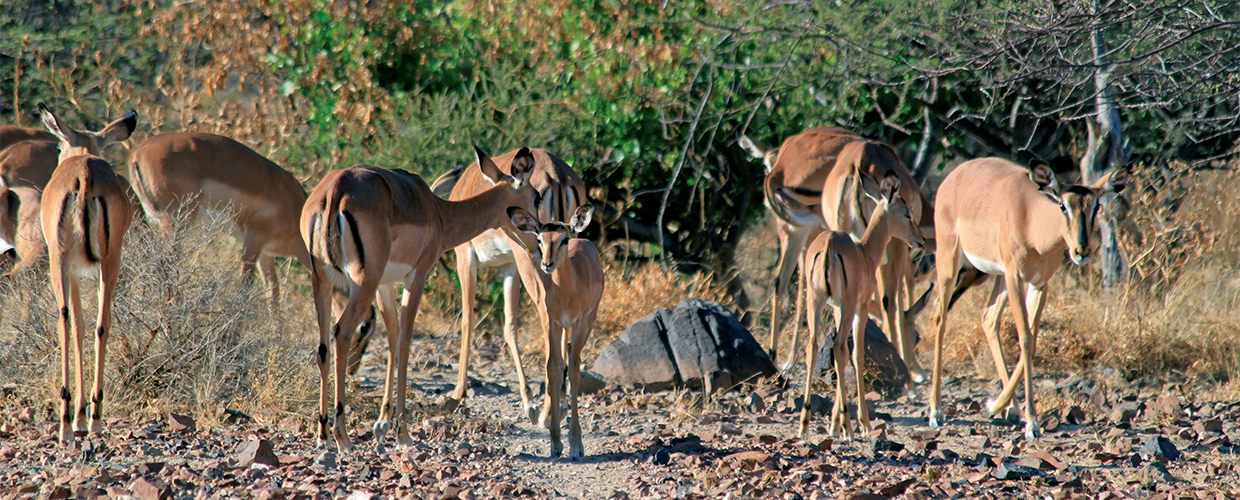
THE IMPALA
An animal of exceptional beauty
The sheer variety of African antelope makes it difficult to single out any particular one for its perfection. Certain species nevertheless have their ardent admirers, of course – like the sable antelope whose exotic looks never fail to attract attention, or the enormous eland which impresses with its massive, muscular appearance. Kai-Uwe Denker
I n the fringe areas, however, where the dense African bush opens into savannah grasslands, a game species has established itself which at first is barely noticed among the variety of antelopes and gazelles. But on closer inspection it stands out through exceptional beauty and harmonious body shape.
Perhaps the impala evolved to such perfection because it shares its habitat in the transition zone between dense bush and open grass savannah with all the large predators and is their first choice of prey. The impala is as important for the leopard’s range of prey as it is for the cheetah’s or African wild dog’s diet. And even though lions mainly prefer large ungulates like zebra or gnu, the prevalence of all carnivores in this habitat poses a particular threat for the impala.
To hold its ground, a species needs acute senses to be extraordinarily alert, and it must be a fast runner as well as a good jumper with a quick response. The impala indeed stands out through the exceptional harmony of its body proportions. It is sturdy but not too heavily built, the limbs are slender but not too long. An adult impala ram is one of the most beautiful ruminants in Africa.
The impala can be regarded as the typical antelope of the southern savannah. It is a mixed forager that needs access to fresh water. Impalas thrive in areas where sparse bushland is interspersed with small clearings, but avoid open plains and thick bush. Dry periods, caused by climatic change in earlier times in the history of the African continent, joined the arid zone at the Horn of Africa to the arid south-western parts of the continent. Along this link, known as drought corridor, animal species which had adapted to drought conditions spread over large parts of the continent – species such as the Oryx antelope, dik-dik, steenbok and others whose geographic range is now disrupted. During more humid periods the drought corridor was broken up by the Miombo woodlands. Species with a low tolerance to drought, like sable antelope and impala, were unable to cross the drought corridor and their occurrence is therefore limited to the southern savannah. Species with a much higher tolerance to drought, however, like the roan antelope, were able to spread across the drought corridor and thus are a common sight in the north-western savannah. Sable antelope and impala in the south-western parts of Africa showed a very interesting development. Apparently both species spread widely across Angola during more humid periods. Since during dry spells their range was interrupted by the drought corridor, geographically isolated subspecies were able to evolve: the giant sable antelope in central Angola and the black-faced impala in south-western Angola and north-western Namibia.
Black-faced impala used to be widely distributed in the northern and north-western parts of Namibia and south-western Angola. The Angolan population of black-faced impala seems to have disappeared almost entirely. Namibian populations have recovered well but are now threatened by cross-breeding with southern impala which were introduced to the area. In Namibia the southern impala used to occur in the north-eastern parts only, in today’s Zambezi, Kavango and Otjosondjupa regions.
The social structure during the rut is characterised by aggressive territorial behaviour among the males, while females and young animals form herds of varying size and pass through the males’ territories. Outside the mating season the territorial behaviour of the males decreases considerably. Dominant rams are mostly solitary; young males from the age of two and old rams of more than six years form bachelor groups.
Territorial impala rams vehemently defend their territory, and the fierce fighting between them sometimes results in substantial injuries. Especially during the rut, males give out noisy roars ending in a short low snort. At the same time they raise and splay their bushy tail so that the white underside is displayed. The tail is particularly pronounced in black-faced impalas.
An impala ram reaches prime condition at four years old and takes on his role as a dominant territorial male. For this species the rut is so exhausting, however, that rams can rarely defend their status as territorial male for more than two rutting seasons before they are ousted by a younger one.
Females give birth at the start of the rainy season and keep the fawn hidden in dense vegetation at first. Fawns are particularly vulnerable to stalking jackals and caracals at this time. But from about ten days old, when they follow their mothers, they are already so quick and agile that they can elude most enemies.
It is not particularly difficult to hunt impalas. Populations in good biotopes are usually quite large, and slow and careful stalking through sparse bushland is as promising as searching an area with binoculars from elevated viewing points to choose an animal for the stalk. The impala is one of those species which are usually taken in passing, but the beautiful lyre-shaped horns are always a particularly attractive trophy.
THE DISTRIBUTION OF IMPALA IN SOUTHERN AFRICA

IMPALA
Aepyceros melampus
| Shoulder Height: | 80-95cm |
| Mass: | 45-80kg |
| Diet: | Mixed forager |
| Rut: | In southern Africa at the start of the winter (May), in east Africa during the rainy season |
| Distribution: | In the southern savannah from Kenya, Uganda, Rwanda and Tanzania to the Gauteng Province of South Africa |
| Appearance: | Rams are more sturdily built, strong neck; females are not horned |
